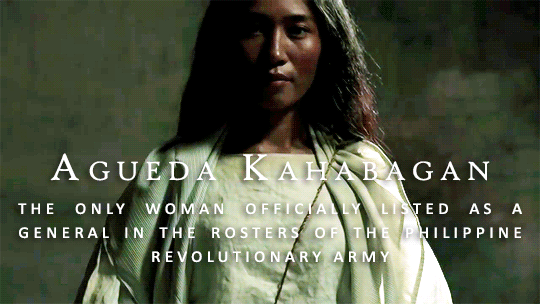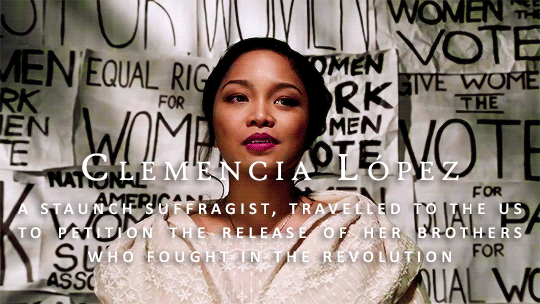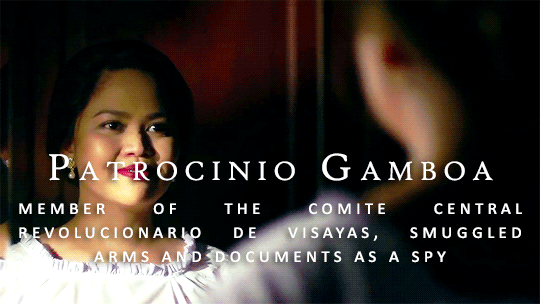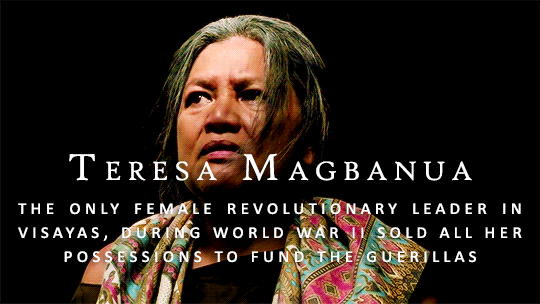#teresa magbanua
Explore tagged Tumblr posts
Text
TERESA MAGBANUA // RESISTANCE FIGHTER
“She was a Filipino schoolteacher and military leader. Born in Pototan, Iloilo, Philippines, she retired from education and became a housewife shortly after her marriage to Alejandro Balderas, a wealthy landowner from Sara, Iloilo. When the 1896 Philippine Revolution against Spain broke out, she became one of only a few women to join the Panay-based Visayan arm of the Katipunan, the initially secret revolutionary society headed by Andrés Bonifacio.”


3 notes
·
View notes
Note
any hcs on piri's name?
Gabriel Maliksi "Boy Kidlat" Magbanua y Bautista
I knowww. It's too on the nose to name him after women revolutionaries: Gabriela Silang and Teresa Magbanua, or to give him Bautista as a (former) surname, because he was baptized.
Now, Maliksi means speedy or agile. It's more common as a surname than a first name, I believe. Since I headcanon Piri to be born in the 1200s or 1300s, the other ethnolinguistic groups within the PH archipelago we know today just aren't sure what group he's supposed to represent (until 1521) and soon took him under their care, as a "messenger" of some sorts. One guardian would task him to deliver a message to another guardian about a war or conflict, and he delivers fast! Maliksi then became his name.
Antonio baptized him as Gabriel Bautista, and Gabriel is also the archangel who delivers messages. He takes Magbanua and adds Maliksi in his official papers upon his independence. He also had a comic and superhero phase with Alfred, and so he gave himself the nickname "Boy Kidlat" (or Lightning Boy). The older PH ethnolinguistic groups still call him Maliksi, and everyone else who can't pronounce his name goes with Gabriel or "Gabbie".
He's technically Gabriel Maliksi B. Magbanua now, but sometimes, he claims that the B stands for Boy Kidlat instead of Bautista.
Now, fem! Philippines would obviously be Gabriela Luningning "Neneng" Magbanua y Bautista, and Piri would tease her because of that song Neneng B (that's not very feminist of you, Piri)
((I would very much love to hear other Filipinos' thoughts on this!))
#hetalia#hws philippines#i wanted to name Piri as Joven just because it means youthful#but I opted to use Gabriel instead#he has Gabriel vibes
18 notes
·
View notes
Note
favorite historical figures
haii anon i'm not sure if you mean local or foreign so i'm answering both lmaooo
LOCAL: nieves fernandez, teresa magbanua, trinidad tecson, and ramon magsaysay i guess
FOREIGN: rosa parks, joan of arc, and napoleon
#userligaya#*mga tugon ni injel sa mga liham#i'm saying all this based on what i can remember from ap/hekasi/polgov. and my memory is.#i know abt contemporary politics better than all this bc i forgor most of the info#pero if we're talking abt historical figures kahit in films#im adding padre burgos sa list <3#and probably all of henry viii's wives
2 notes
·
View notes
Link
0 notes
Text



Ma'am Natasha Kintanar (Book Author) #Idol
One of My Favorite Author
Book Release
Bayani Biographies: Teresa Magbanua and Bayani Biographies: Gregoria de Jesus
Book Sign at Manila International Book Fair
1 note
·
View note
Link
0 notes
Text
China and Philippines trade blame as ships collide

China and the Philippines have accused each other of ramming coast guard vessels in a disputed area of the South China Sea. The Philippines has claimed a Chinese ship "directly and intentionally rammed" into its vessel, while Beijing has accused the Philippines of "deliberately" crashing into a Chinese ship. Saturday's collision near the Sabina Shoal is the latest in a long-running - and escalating - row between the two countries over various islands and zones in the South China Sea. Within the past two weeks, there have been at least three other incidents in the same area involving ships belonging to the two countries. The Sabina Shoal, claimed by China as Xianbin Jiao and as Escoda Shoal by the Philippines, is located some 75 nautical miles from the Philippines' west coast and 630 nautical miles from China. The South China Sea is a major shipping route through which $3 trillion worth of trade passes through a year. Beijing claims almost all of the South China Sea, including parts claimed by the Philippines, Brunei, Malaysia, Taiwan and Vietnam. Following the latest clash, China's coast guard called on the Philippines to withdraw from the Sabina Shoal while pledging to "resolutely thwart all acts of provocation, nuisance and infringement". The Philippines coast guard said it would not move its vessel - the Teresa Magbanua - "despite the harassment, the bullying activities and escalatory action of the Chinese coast guard". There were no casualties following the crash but Philippines Coast Guard Commodore Jay Tarriela said that the 97-meter (318-feet) Teresa Magbanua had sustained some damage after being hit "several times" by the Chinese ship. The US ambassador to the Phillipines, MaryKay L Carlson, criticised what she called China's dangerous actions in the region. "The US condemns the multiple dangerous violations of international law by the , including today's intentional ramming of the BRP Teresa Magbanua while it was conducting lawful operations within the EEZ." she wrote in a post to X. "We stand with the Philippines in upholding international law." China has repeatedly blamed the Philippines and its ally the US for the escalating tensions. Last week, a defence ministry spokesperson said Washington was "emboldening" Manila to make "reckless provocations". Observers worry the dispute could eventually spark a larger confrontation in the South China Sea. A previous attempt by the Philippines to get the United Nations to arbitrate ended with the decision that China had no lawful claims within its so-called nine dash line, the boundary it uses to claim a large swathe of the South China Sea. Beijing has refused to recognise the ruling. But in recent weeks both countries have made an attempt to de-escalate the immediate conflicts out at sea. Last month they agreed to allow the Philippines to restock the outpost in the Second Thomas Shoal with food, supplies and personnel. Since then this has taken place with no reported clashes. Read the full article
0 notes
Video
youtube
South China Sea :Chinese Coast Guard vessel rammed BRP Teresa Magbanua o...
0 notes
Text
The Female Soldier
Filipina Warrior
10 Filipina Warriors And Their Battles That Made Philippine History
During times of war when women were expected to play secondary roles to men, these badass Filipina warriors chose to march to the forefront, engage in battle, and bravely fight for the country's independence and freedom.

1. Gabriela Silang, 2. Teresa Magbanua , 3. Melchora Aquino, 4. Trinidad Tecson, 5. Josefa Llanes Escoda, 6. Magdalena Leones, 7. Agueda Kahabagan, 8. Nieves Fernandez, 9. Josefina Guerrero, 10. Carmen Rosales
They were rebel leaders, undercover messengers, and silent assassins.
10 Filipino Heroines That You Need to Know (esquiremag.ph)

“While women in precolonial Philippines were often designated to the venerable position of the babaylan [shaman], it was not an uncommon occurrence for them to pick up arms and become warriors.”
Perry Gil S. Mallari, The Filipina as Ritualistic and Warrior
thefemalesoldier
346 notes
·
View notes
Text
USAID Grants Over Php65 Million for Energy Security and Conservation in Cagayan and Isabela

Manila, June 20, 2023—The United States Agency for International Development (USAID) has awarded more than Php65 million ($1.16 million) in grants to support energy security and conservation in the provinces of Cagayan and Isabela. This significant funding was announced by USAID Assistant Administrator for Asia, Michael Schiffer, during his visit to the Philippines from June 15 to 18.
Boosting Energy Security and Conservation
The grants have been provided to USAID's Filipino partners, Tri-Sky Inc. and the Philippine Disaster Resilience Foundation, as part of the Energy Secure Philippines program, which has a total budget of Php1.6 billion ($34 million). The funds will be used to facilitate local energy planning and the implementation of renewable energy technologies, including solar roofing and nano generators, in the provinces. The aim is to enhance energy access in remote communities, enabling them to better prepare for and recover from natural disasters. Furthermore, the communities surrounding the Enhanced Defense Cooperation Agreement sites in Lal-lo and Santa Ana will also benefit from these grants.
"Energy is the Foundation for Prosperity"
Assistant Administrator Schiffer emphasized the importance of energy in supporting essential services such as banking, telecommunications, digital platforms, health, education, and transportation. "USAID understands that energy is the foundation for various systems," he said. He also expressed enthusiasm for the partnership with the Philippines to expand access to sustainable energy in remote communities, ultimately improving the prosperity of families across the country.
Preserving Forests in Sierra Madre
In addition to the energy grants, Assistant Administrator Schiffer launched the "From Ridge to River" project in collaboration with the Mabuwaya Foundation and the Agta Indigenous Peoples community at Sitio Golden Valley in Barangay San Mariano. This initiative aims to conserve forests in the northern Sierra Madre region. USAID will work closely with local communities, partners, and government officials to safeguard the natural beauty and ecological balance of the area. Assistant Administrator Schiffer applauded the project's launch, emphasizing the importance of preserving the region's biodiversity.
Assistant Administrator Schiffer's Itinerary
During his visit to the Philippines, Assistant Administrator Schiffer also delivered a speech at the Asian Development Bank's annual Asia Clean Energy Forum in Manila. He also took the opportunity to visit a USAID-supported drug rehabilitation program in Mandaluyong City. Additionally, during his visit to Palawan, Assistant Administrator Schiffer had the opportunity to explore the breathtaking Puerto Princesa Subterranean River National Park. He also witnessed the efficient waste collection and sorting practices in place. Furthermore, he engaged in fruitful discussions with civil society organizations concerning the pressing issue of illegal fishing in the Philippines' exclusive economic zone. Lastly, he gained valuable insights into the commendable efforts of the Philippine Coast Guard in safeguarding marine resources in Philippine waters aboard the BRP Teresa Magbanua. Sources: THX News & US Embassy in the Philippines. Read the full article
#AssistantAdministratorSchiffer#CagayanandIsabela#conservationgrants#EnergySecurity#philippines#remotecommunities#renewableenergytechnologies#SierraMadre#sustainableenergy#USAID
0 notes
Text
I've always wanted to combine my love for language of flowers & my wish to make filipina heroes merch, so here we are. It was originally just four but I wanted the add the others I've planned eventually.

Filipina heroes as follows(start upper left)
1. Teresa Magbanua - daisy
2. Gregoria de Jesus -red rose
3. Urduja(new)- mimosa
4. Melchora Aquino - peonies
5. Gabriela Silang - gladiolus
6. Maria Clara(new) - tulips
#artph#art#artwork#jtdrawsalot#painting#jtdrawsalotart#filipinoartist#artsy#jtdrawsalotmerch#ph history#maria clara#teresa magbanua#oryang#henlu#heneral moon#heneral goon#melchora aquino#urduja#gabriela silang
17 notes
·
View notes
Note
from your nyo! piri reblog, it's cute how the artist named her after their favorite song. which made me wonder, what's your nyo! piri's name and what's the story behind it?
Ooh! obmessed's writings and art are *chefs kiss*! My nyo! Piri is also named Gabriela. Her name echoes what I named Piri as well.
Her full name is Gabriela Luningning Magbanua y Bautista, but in modern naming conventions, it would be Gabriela Luningning B. Magbanua.
It's a tribute to Filipina heroes, Gabriela Silang and Teresa Magbanua. Luningning means bright or twinkle (like the stars). It was what the people called her when she was born. It's not a common name anymore but it's legitimate (the key is to search this on facebook: "[random name] Garcia" lmao). Bautista is very literal because she was dipped in the water and baptised.
Other nations call her Gabbie but her elders (Maynila, Sugbu, Butuan, Sulu, etc.) still call her Luningning.
I actually headcanon that Antonio gave her the name Josefina Gabriela Bautista because there are too many Marias in the world already. Upon her independence, she renews her papers again and decides what her name should be.
#hetalia#hws philippines#hetalia world stars#nyo! philippines#hws nyo! philippines#hws nyo philippines
3 notes
·
View notes
Photo








“Clearly the women were not a captive audience in the war among armed men. When they moved, singularly or collectively, the revolution did not stand still.” — Camagay, Maria Luis. “Kababaihan sa Rebolusyon (Women in Revolution).” Kasarinlan: Philippine Journal of Third World Studies 14.2 (1998).
the women of the philippine revolution, in honor of national heroes’ day
#historyedit#perioddramaedit#documentaryedit#history#philippines#gabriela silang#gregoria de jesus#teresa magbanua#agueda kahabagan#clemencia lopez#leona florentino#melchora aquino#patrocinio gamboa#kababaihan ng rebolusyon#<- that's the name of the documentary i used#lupain ng ginto't bulaklak#nadz rambles#*gifs
1K notes
·
View notes
Text
New Episode of My Hugot Podcast Teresa Magbanua Part 2 - Rise
The inevitable war breaks out. And so too does Teresa's call for battle. But it wasn't an easy road for her. Or any woman, really. Check out @hugotPodcasting on Twitter! And check out our newest show The Mountain's Heart ---- Transcript available on our website: www.miscellanymedia.online/transcripts Music for this Episode by Sounds Like an Earful: Soundslikeanearful.com Sound Effects from Freesound.org Twitter: @MiscellanyMedia Tumblr: miscellanymedia Support the project: www.ko-fi.com/mmstudios
#teresa magbanua#history#Filipino#filipino history#filipino studies#myhugot#my hugot#podcast#podcast transcript#new podcast episode
1 note
·
View note
Photo




“Ang kalagayan ng bansa sa isang panahon ay lumilikha ng natatanging kalipunan ng mga bayani.”
(The situation in the country at a particular time creates its own breed of heroes.)
General Teresa Magbanua y Ferraris (October 13, 1863 – August 1947) was a Filipino revolutionary leader and the only woman to lead troops in the Visayas during the Revolution. She is one of the few Filipinos to have participated in all three resistance movements in the Philippines: against Spain in the Philippine Revolution, against the United States in the Philippine–American War, and against Japan in the Second World War.
Teresa was born in Pototan, Iloilo to affluent parents Don Juan Magbanua, who was then a judge of a sala of the Court of First Instance in Iloilo City, and Doña Alejandra Ferraris. Teresa’s sister Paz described her as having “a dynamic personality, always restless for action and afraid of no man.” As a child, Teresa was closest to her younger brothers Manuel and Elias who, as fate would have it, would also fight alongside her during the Revolution.
Teresa was highly educated, studying first at the Colegio de San José in Jaro, Iloilo, and later on being sent to Manila to study at three different schools: the Colegio de Santa Rosa in 1884, the Colegio de Santa Catalina in 1886, and the Colegio de Doña Cecilia in 1894, where she earned a certification as a teacher. She then went on to the University of Santo Tomas to qualify for cuarto suprema and was conferred the degree of Maestra Titulada Superior.
In 1894, Teresa married Alejandro Balderas, a wealthy landowner. During the course of her marriage, Teresa learned all the particulars of running a farm and even learned to become a fine horsewoman and an excellent markswoman, skills she would later put to good use years later during the Revolution.
October 1898 saw Iloilo entering the war, and when Teresa learned that her brothers have enlisted in the revolutionary army, she went to her uncle General Perfecto Poblador, the commander of the Northern Zone, and asked to join as well despite the protests of her husband. Thus Teresa became a member of the Kataas–taasang, Kagalang–galangang Katipunan ng mga Anak ng Bayan (The Most High and Venerable Society of the Sons of the Nation) or the K K K, not to be confused with the American white supremacist group.
Teresa was given the command of a bolo battalion by her uncle. She saw her first battle at the Battle of Barrio Yating in Pilar, Capiz, where she led the charge while on horseback. She also fought in the battle at Sap–ong Sara on December 3, 1898, defended the Balantang–Tacas–Jiabo–an line in 1899, and managed to kill 400 Americans despite having few men and fewer weapons during the battle of Balantang, Jaro on March 10, 1899.
After brothers’ deaths due to treachery in 1899 and after the fall of the revolutionary army’s regional headquarters in Santa Barbara to Americans, Teresa had to resort to using guerrilla tactics. In 1900, Teresa, alongside the most important leaders of Panay, surrendered to the Americans and she once again returned to farming.
Forty years later, when the Japanese occupied the Philippines, Teresa once again displayed her heroism despite her advanced age by selling all her personal belongings in order to purchase food and supplies to support the local guerrilla resistance who fought in the battle for the liberation of Iloilo. Afterwards, Teresa moved to Pagadian, Zamboanga del Sur where she lived with her sister Maria until her death in August 1947, the exact date unknown and her burial unannounced with only close friends in attendance.
#historyedit#perioddramaedit#history#teresa magbanua#filipino history#asian history#southeast asian history#gif#our edits#by nadz#19th century#20th Century#world war II#i'm only partly sorry about the wall of text#[john mulaney voice] THATS MY WIFE#I HATE THAT I HAD TO EXPLAIN THE THING ABOUT THE KATIPUNAN BECAUSE I KNOW SOME PEOPLE WOULD ASSUME THINGS#edited because apparently it didn't show up in the tags
124 notes
·
View notes
Text
when i make hanan's family name "magbanua" then what
2 notes
·
View notes